-
Images show aftermath of Damascus strikespublished at 22:48
We’ve just received more pictures of the damage in Damascus following Israeli strikes, which have killed at least three people and injured another 34.
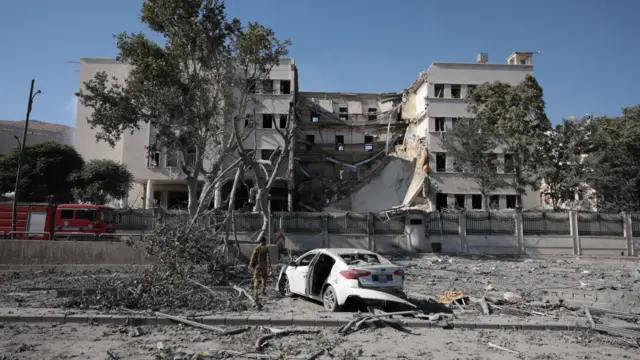 Image source,EPA
Image source,EPAImage caption, The defence ministry building in the Syrian capital was one of the targets
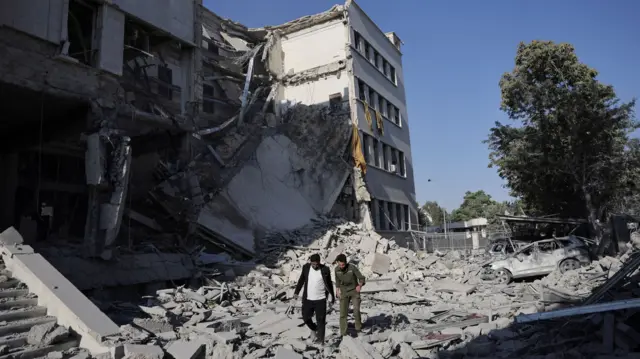 Image source,Reuters
Image source,ReutersImage caption, Israel says it launched strikes on Damascus to destroy Syrian forces that it says are attacking the Druze community
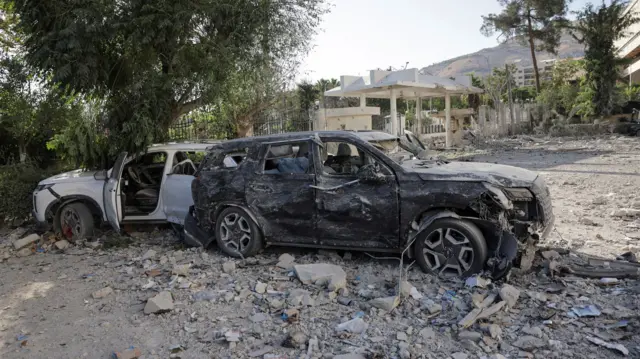 Image source,Reuters
Image source,ReutersImage caption, Destroyed cars sit on the roads in the aftermath of the Israeli strikes
-
Druze community’s quest for autonomy source of tensionpublished at 22:42
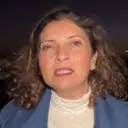 Lina Sinjab
Lina Sinjab
Middle East correspondent, reporting from BeirutSince the fall of Bashar al-Assad in December, the Druze community in Suweida has resisted any reassertion of central government authority. While not all Druze factions agree, many rejected the presence of official Syrian military or security forces in their main city, opting instead to govern and protect themselves through local militias.
This desire for autonomy sparked growing tensions with Bedouin groups in the region, many of whom are backed by the new Islamist-led government in Damascus.
What began as a fragile balance quickly unravelled. Clashes erupted on Sunday between Druze fighters and Syrian troops deployed under the pretext of restoring stability. But reports from local sources say those forces committed abuses – killing civilians, looting homes, and humiliating community leaders. A ceasefire brokered yesterday collapsed within hours.
Israel’s intervention has further complicated the landscape. Its strikes appear aimed at deterring Damascus from pushing into Suweida, but they also raise the stakes of a broader sectarian or regional spill over.
For now, the Druze face a difficult reality: their calls for autonomy clash directly with Damascus’s determination to reassert control. With blood already spilled and outside powers now involved, the path forward looks increasingly volatile and uncertain.
-
Three killed and 34 injured in Damascus – health ministrypublished at 22:37
BreakingThree people have been killed in Israeli strikes on Damascus, the Syrian health ministry reports.
A further 34 have been injured, the ministry adds in its latest update on the impact of the attacks.
-
What we know so farpublished at 22:25
If you are just joining our coverage or need a quick recap, let’s bring you up-to-date with the key developments in the last few hours:
- Israel has intensified its airstrikes on Syria, including hitting the defence ministry and area near the presidential palace in the capital Damascus
- Israel says its forces are protecting the minority Druze community – and aiming to eliminate pro-government forces accused of attacking them in Syria’s south-western Suweida region
- It comes after days of deadly clashes between armed Bedouin groups and Druze militia in Suweida
- US envoy Tom Barrack has called on all parties to “step back” from violence which has escalated in recent days
- The UK-based Syrian Observatory for Human Rights (SOHR) monitoring group says more than 300 people have been killed since fighting erupted on Sunday

-
IDF says it is ‘increasing pressure and pace of strikes’ on Syriapublished at 22:15
We’ve just heard another update from the Israel Defense Forces, which says its troops are “operating decisively in the Suweida region”.
In a statement, a commander says Israeli forces are “targeting Syrian regime assets in the area” and are “increasing the pressure and pace of the strikes”.
And, after the Syrian defence ministry headquarters was hit by air strikes, the IDF official adds that Israel has “also struck in Damascus and will continue to strike in the southern Syria region”.
As a reminder, earlier reports from Syria indicated a ceasefire had been declared in Suweida – the fourth since Sunday.
-
Watch: Syrian state TV shows strike on military HQpublished at 22:10
Footage from Syrian state broadcaster Syria TV shows the moment the country’s military headquarters was hit.
You can watch that video below.
As we reported a little earlier, the Israeli military said it had struck the entrance of the Syrian government’s military headquarters, in the capital Damascus.
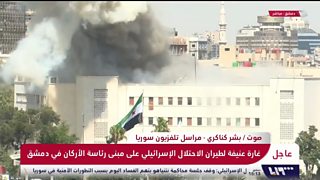
-
Severe damage to defence ministry buildingpublished at 22:01
Pictures are now coming in showing the extent of the damage done to Syria’s defence ministry headquarters.
Traffic has been stopped as security forces work in the area. Debris can be seen strewn in the surrounding roads and the front of the building has been partially destroyed.
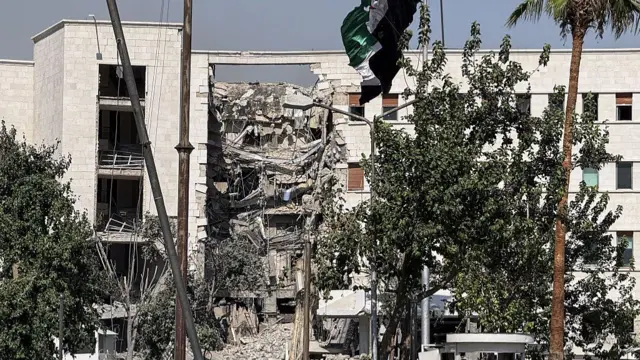 Image source,Abdulkarem Al-Mohammad/Anadolu via Getty Images
Image source,Abdulkarem Al-Mohammad/Anadolu via Getty Images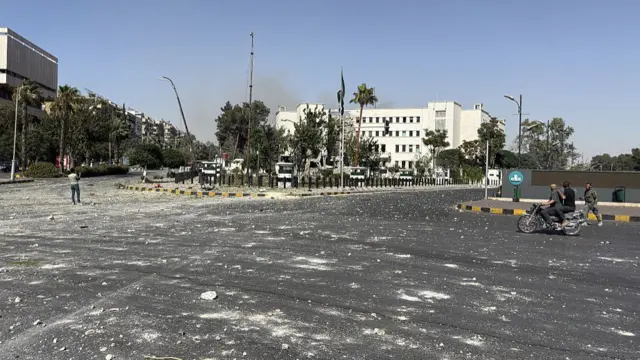 Image source,Abdulkarem Al-Mohammad/Anadolu via Getty Images
Image source,Abdulkarem Al-Mohammad/Anadolu via Getty Images -
Number of injured rises to 28 – Syrian health ministrypublished at 21:56
BreakingThe number of people injured in Damascus has risen to 28, the Syrian health ministry says in an update on the impact of Israelis strikes.
It had previously reported one person killed and 18 injured.
-
Reports of new ceasefire in Suweida, as death toll exceeds 300published at 21:50
A ceasefire agreement has been reached in Suweida, Syrian state news agency Sana has reported.
Citing an interior ministry source, the report says security checkpoints have been set up in the city, which Sana says will now be fully integrated into the Syrian state.
This is the fourth such ceasefire declared in Suweida since Sunday, all of which have swiftly broken out into further clashes.
For context, more than 300 people have been killed in southern Syria in recent days, according to the UK-based Syrian Observatory for Human Rights (SOHR) monitoring group.
Since fighting erupted on Sunday in Suweida, SOHR says 69 Druze fighters have been killed as well as 40 civilians.
SOHR says 27 of the Druze were killed in “summary executions” by government forces.
A further 165 Syrian troops and 18 Bedouin fighters have been killed, SOHR reports. It also says 10 members of the security forces have been killed in Israeli strikes.
-
Israeli strikes have political motive, as well as militarypublished at 21:39
 Lina Sinjab
Lina Sinjab
Middle East correspondent, reporting from Beirut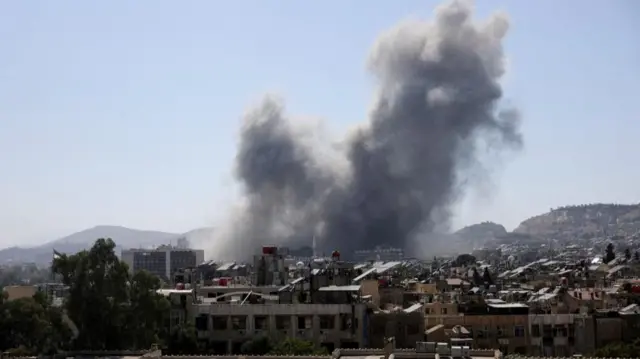 Image source,Reuters
Image source,ReutersWhile Israel’s strikes in Syria may appear to be a show of strength, they reflect more than simple muscle-flexing.
Syria’s post-Assad government is still in its infancy – its army and security forces are weak, fragmented, and struggling to assert control.
In the immediate aftermath of former dictator Bashar al-Assad’s fall in December, Israel launched a sweeping wave of air strikes, targeting more than 400 military sites in just 48 hours.
The intent was clear: to prevent any rapid militarisation that could threaten Israeli security, particularly near its northern border.
Although the new Syrian leadership has signalled it has no appetite for regional war – and quiet, US-backed negotiations with Israel may be under way. Israel sees a red line in the presence of what it regards as Islamist-aligned forces near Druze communities and the Israeli buffer zone.
The strikes are as much a deterrent as they are a warning.
But the campaign is not without consequence. It’s stirring anger on the Syrian street and even dividing opinion among Druze, some of whom reject any association with Israel.
Ultimately, these strikes are as political as they are military, aimed at shaping the emerging post-Assad order before it hardens.
-
Three commanders killed in Israeli strikes on south, Syrian campaign group sayspublished at 21:31
Three Syrian commanders leaders have been killed in Israeli strikes on southern Syria, according to the Syrian Observatory for Human Rights (SOHR) monitor.
The UK-based campaign group – which monitors and releases reports on casualties in Syria – says the strikes specifically targeted military convoys as defence ministry officials gathered.
It says the strikes came down in the countryside around the villages of Walgha and al-Majimar, near the city of Suweida where clashes between armed Druze and Bedouin groups have taken place in recent days.
The SOHR previously reported that seven military officials were killed in previous Israeli strikes in Suweida, including on a tank and military vehicle – bringing the total count to at least 10.
-
US ‘talking to both sides’ to end Syria fighting, Marco Rubio sayspublished at 21:22
 Image source,Kent Nishimura for The Washington Post via Getty Images
Image source,Kent Nishimura for The Washington Post via Getty ImagesUS Secretary of State Marco Rubio says “we’re very concerned” about the Israeli strikes on Syria.
He tells reporters that the US wants the fighting to end and confirms they are “talking to both sides”, adding that hopefully they can stop it.
Rubio adds there will “hopefully” be updates later.
-
Watch: Smoke billows over central Damascuspublished at 21:11
Large plumes of smoke have been seen rising from central Damascus, after what appears to be hits on the Syrian defence ministry building in Umayyad Square.
It follows powerful Israeli airstrikes that shook the capital earlier. Watch below:
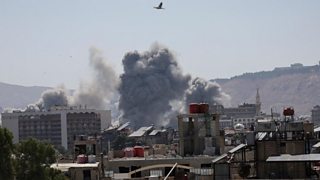
-
Strikes on Damascus follow clashes between Druze and Bedouinpublished at 21:05
Israel’s strikes on Damascus on Wednesday come after armed clashes between Sunni Bedouin fighters and Druze militias in southern Syria began at the weekend.
The violence erupted in the predominantly Druze city of Suweida on Sunday, two days after a Druze merchant was reportedly abducted while travelling by road to Damascus.
On Tuesday, after two days of the deadly clashes, Israel said it had bombed Syrian government forces around Suweida.
Syrian forces have been accused of also attacking the Druze. The government has not responded to then specific allegations, but has condemned the attacks on Druze people and said its troops are there to restore order.
Israel’s prime minister Benjamin Netanyahu said he had ordered strikes on forces and weapons in the area because the government “intended to use [them] against the Druze”. Syria has condemned Israel’s involvement.
At least 200 people have been killed since the clashes started on Sunday, the UK-based monitoring group the Syrian Observatory for Human Rights said on Tuesday.
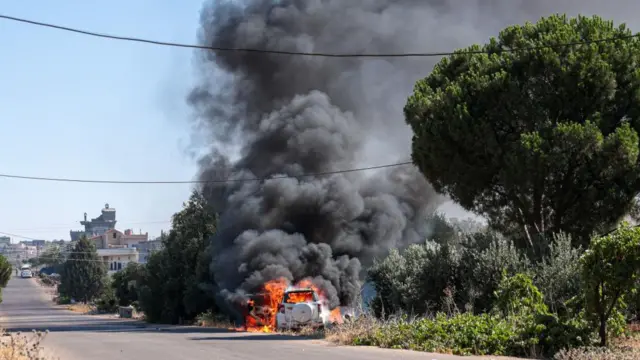 Image source,EPA/Shutterstock
Image source,EPA/ShutterstockImage caption, A burning car near Suweida yesterday, following clashes between armed Druze and Bedouin groups – and the deployment of Syrian government forces
